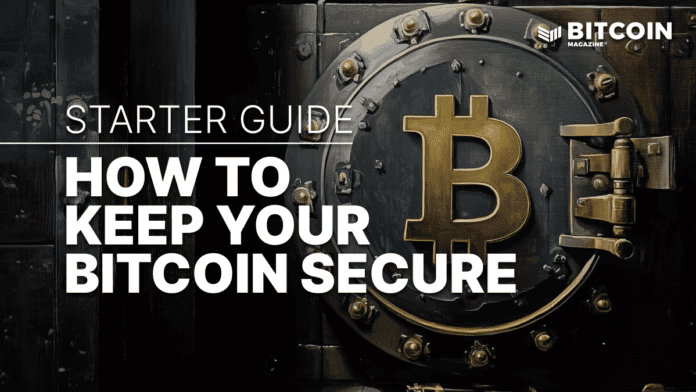Introduction
Unlike traditional bank accounts, Bitcoin’s security depends on who controls the cryptographic keys that grant access to bitcoin. Taking personal ownership—known as self-custody—eliminates reliance on exchanges, brokers, or banks, placing full responsibility in your hands.
By securing your bitcoin with a personal wallet, you prevent third parties from freezing your funds, seizing your assets, or blocking transactions. Unlike bank-held fiat-currencies, self-custodied Bitcoin remains entirely under your control.
This guide outlines essential steps for protecting your bitcoin and why self-custody is a responsibility every Bitcoiner should take seriously.
Step 1: Get Your Bitcoin Off Exchanges
For beginners or those holding small amounts of bitcoin, it might seem convenient to leave it on the exchange where it was purchased. However, this should only be considered a temporary solution, as it means you are forgoing ownership of your bitcoin to a third party. In addition, numerous exchanges have been hacked: MtGox in 2011, Bitstamp 2015, BitFinex 2016, and Binance in 2019. We’ve also witnessed exchanges entirely collapse, as was the case with FTX in 2022. Exchanges do not offer a deposit guarantee scheme, or afford customers with any such protections. If an exchange loses your coins, consider them lost.
Furthermore, exchanges impose strict KYC/AML (know-your-customer/anti-money laundering) requirements, freezing funds until users submit ever more intrusive personal documentation, such as videos, bank statements, proof of employment, and so forth.
While your bitcoin is on an exchange, keep these important considerations in mind:
- Get In, Get Out: An exchange’s primary purpose is to facilitate transactions. After buying, move your bitcoin to a personal wallet to assume control.
- Keep Passwords Private: Never share passwords and always use strong, unique ones for each platform.
- Use a Password Manager: Avoid password reuse by using a secure password manager.
- Exchanges Are Not Savings Accounts: Some exchanges may offer yields on bitcoin, but they lack the protections of regulated banks.
- Temporary Usage Only: Once your bitcoin holdings exceed a few hundred dollars, self-custody is highly recommended.
Read more >> Why and How To Withdraw Your Bitcoin From Exchanges
Step 2: Self-Custody Options
Taking control of your private keys eliminates third-party risks and ensures your bitcoin remains entirely under your control. To achieve this, you need a reliable method to secure your keys.
Below, we outline various self-custody solutions, ranging from simple setups ideal for smaller amounts to advanced strategies suited for larger amounts. Each option balances security, convenience, and complexity differently, and the right choice depends on your individual needs. While no single solution is perfect, understanding the trade-offs will help you make an informed decision.
Solution 1: Mobile or Desktop Wallets
A mobile or desktop wallet enables you to hold bitcoin outside of an exchange, offering more control over your funds. These wallets are suitable for small amounts of bitcoin used for everyday purchases. While more secure than exchanges, they still have vulnerabilities, especially when connected to the internet. Options like BlueWallet, Wasabi, or Electrum are robust choices.
Best for: Users who want control over small amounts of bitcoin for regular use or over the Lightning Network (Bitcoin Layer 2).
Advantages:
- Control: Allows full access to private keys, offering more sovereignty than exchanges.
- Backup-friendly: Recovery phrases make it easy to restore wallets if a device is lost or damaged.
- Convenience: Perfect for daily transactions and integration with the Lightning Network for near-instant payments.
Disadvantages:
- Online risks: Vulnerable to malware, phishing, and device-level attacks due to internet connectivity.
- Not for large holdings: A poor choice for long-term storage or for significant amounts of bitcoin.
Advanced Tip: Use mobile wallets in conjunction with a hardware wallet for improved security. For example, you can use Electrum to connect your hardware wallet and sign transactions offline, adding an extra layer of protection.
Privacy Tip: Use privacy-enhancing wallets like Ashigura to prevent transaction linkage and improve pseudonymity.
Solution 2: Single Hardware Wallet, Stored in a Secure Location
A hardware wallet is a specialized physical device that securely stores Bitcoin private keys offline. This solution is among the most secure and accessible for individuals focused on self-sovereignty.
Best for: Users planning to accumulate bitcoin over time, especially for long-term holdings, inheritance, or retirement savings.
Advantages:
- Offline safety: Keeps private keys completely offline, mitigating hacking risks.
- User-friendly: Provides a straightforward setup process with clear instructions.
- Compatibility: Works seamlessly with wallets like Electrum for enhanced usability.
Disadvantages:
- Learning curve: Requires some initial effort to understand setup, backups, and usage.
- Irrecoverable if mishandled: Losing both the hardware device and recovery phrase means permanent loss of funds.
Advanced Security Tip: Use a passphrase (an optional feature on many hardware wallets) to create an extra layer of protection. This is particularly valuable if the recovery phrase is compromised.
Practical Tip: Store the recovery phrase in a fireproof and waterproof safe, and never store it digitally. Consider splitting the phrase into two parts and storing them in different secure locations. Better yet, emboss your seedphrase on a metal backup.
Provenance Tip: Always buy directly from the manufacturer or a trusted reseller to avoid tampered devices.
Solution 3: Multisignature Wallet
Multisignature wallets (multisig) are often considered the gold standard for advanced Bitcoin security. Multisig requires multiple keys to sign and execute a transaction, significantly reducing the risk of loss or theft.
Multisignature setups come in two forms: self-custody, where users manage all keys independently, and collaborative custody, where a trusted third party holds one key to assist with security and recovery.
Best for: Those with substantial bitcoin holdings who need advanced security and resilience against a single point of failure. Ideal for those planning for inheritance, shared custody, or frequent travelers who want peace of mind knowing their bitcoin remains secure even if they are away for extended periods.
Advantages:
- Robust security: Reduces risk by requiring multiple keys, making unauthorized access nearly impossible.
- Inheritance planning: Enables secure ways to pass bitcoin to heirs, even if one key is lost.
- Customizable setups: Supports complex configurations such as timelocks and collaborative custody.
Disadvantages:
- Complex setup: It can be tricky for non-technical people to implement and manage effectively.
- Cost: Multisig is more costly than single-sig, as it requires multiple hardware wallets, some solutions require ongoing service fees. On-chain fees will be higher too, due to the increased transaction size from multiple signatures and public keys, making multisig transactions larger in bytes and more expensive per vByte.
- Key management risks: Losing multiple keys can lead to loss of funds.
Advanced Tip: Use geographically distributed keys to mitigate risks from natural disasters or theft. For instance, one key could be stored in a safe deposit box, another at home, and a third with a trusted provider.
Read more >> The Best Bitcoin Multisig Wallets
Solution 4: Air-Gapped Cold Storage (Offline)
Air-gapped cold storage is the pinnacle of Bitcoin security, where private keys are generated and stored entirely offline. Devices like Coldcard or dedicated air-gapped computers are tailored for this purpose.
Best for: Users safeguarding large amounts of bitcoin over the long term, particularly for generational wealth or institutional-grade security.
Advantages:
- Absolute isolation: Completely immune to online threats, malware, or hacking attempts.
- Customizable security: Allows users to design their setup based on their threat model.
- Ultimate control: No reliance on third parties or online infrastructure.
Disadvantages:
- Steep learning curve: Requires significant technical knowledge to set up and manage effectively.
- Physical vulnerability: Relies heavily on physical security measures (e.g., safe storage).
- Inconvenient for spending: Transactions require careful preparation and signing.
Advanced Tip: Pair air-gapped cold storage with a multisig setup for unmatched security. For example, use Coldcard devices for a 2-of-3 multisig arrangement.
Extra Layer: Use Bitcoin-native tools like PSBT (partially signed Bitcoin transactions) to safely sign transactions offline before broadcasting them from an internet-connected device.
Step 3: Backing Up and Securing Your Keys
Securing your keys is the foundation of safeguarding your bitcoin holdings. Start by writing down your recovery seed — a set of 12-24 words provided by your wallet — on paper, which typically comes standard with most wallet products. Place these written backups in tamperproof and waterproof bags to shield them from environmental damage, such as moisture or accidental spills.
Store the backups in multiple secure locations to reduce risks from theft or loss. For example, you can use a fireproof safe at home or even bury a seed backup in your garden. If you choose the latter, ensure the storage is weatherproof, discreetly hidden to avoid accidental discovery, and accompanied by instructions or clues for trusted family members to locate it in the event of your passing.
To further secure your recovery seed for the long term, consider using metal seed storage solutions like Cryptosteel, Billfodl, or Seedor. These devices are resistant to fire, water, and corrosion, providing durability far superior to paper.
Additionally, implement plausible deniability by using decoy wallets or passphrases. Wallets like Trezor, Ledger, or Coldcard support this feature, allowing you to create hidden wallets accessible only with specific passphrases. In the event of a coercive attack, you can reveal a wallet containing a small, plausible amount of bitcoin while your primary holdings remain secure. By combining resilient physical storage and strategic measures, you can protect your bitcoin effectively while maintaining control over your assets.
Step 4: Practice Precaution
Maintaining Bitcoin security is manageable with a few key precautions that, when practiced consistently, significantly reduce risks to your holdings and personal safety.
Avoid address reuse whenever possible. Each Bitcoin address is meant for one-time use, and reusing addresses can compromise your privacy by allowing malevolent observers to link transactions together. For enhanced privacy, consider using wallets with built-in privacy features, such as those offering transaction obfuscation methods like coinjoins. Similarly, practice strong personal privacy by keeping your contact details, residence, and any other identifiable information off the internet. Sharing too much online could make you a target for phishing, scams, or worse.
Keep all software updated, including wallet firmware, operating systems, and antivirus programs. Exploits and vulnerabilities are regularly patched in updates, so neglecting this step can expose you to unnecessary risks. Where possible, use a dedicated device for Bitcoin transactions — a separate computer or smartphone with a clean install to minimize exposure to malware. A dedicated email address for Bitcoin-related accounts also reduces your risk of being targeted by hackers who may already have access to your usual email from past data breaches.
Where possible, activate two-factor authentication (2FA) on all platforms, but be mindful of the method. Hardware 2FA keys like YubiKey or Google Titan are more secure than SMS-based 2FA, which can be compromised through SIM-swapping attacks.
Finally, adopt a low-profile approach to your bitcoin stack. Discussions about your holdings, even in casual conversation, can attract unwanted attention. Avoid wearing Bitcoin-branded items or displaying merchandise that could signal your involvement to potential attackers. Remember, anonymity is a strength, and many experienced bitcoin holders go to great lengths to protect their identity, with some even masking their presence at conferences or online discussions to safeguard their privacy.
By following these precautions diligently, you can establish strong security practices that will help protect your bitcoin and your personal safety in both digital and physical realms.


